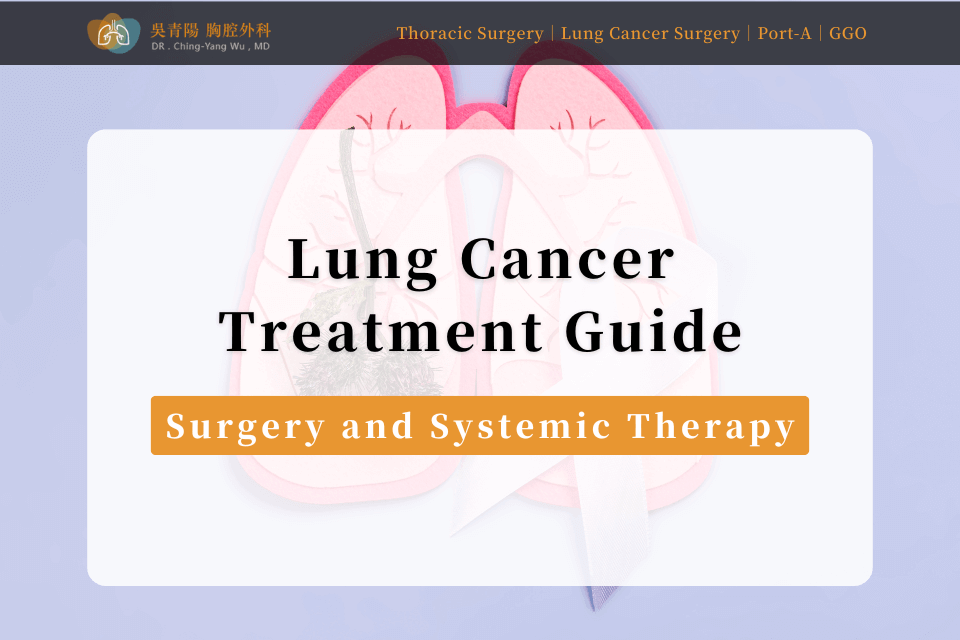
Lung Cancer Treatment Guide: Surgery and Systemic Therapy
Lung Cancer Treatment Guide: Surgery and Systemic Therapy
With advancements in tumor treatment, lung cancer treatment guidelines have continually improved, leading to an increasing number of patients discovering pulmonary lesions during follow-up.
Depending on the clinical scenario, the management approach and recommendations for these lesions may vary.
Lung Cancer Treatment Guide
Treatment Approach for Pulmonary Lesions in Non-Pulmonary Primary Tumors
In clinical scenarios where the primary tumor did not originate in the lungs (such as in breast, colorectal, or liver cancer, etc), the management of pulmonary lesions depends on the stability of the primary tumor (i.e., no local recurrence and no lesions outside the lungs).
If the primary tumor is stable, the treatment approach for lung lesions will be determined by several factors, including the patient's cardiopulmonary function, as well as the location and number of pulmonary lesions.
Pulmonary Treatment Approach: Management of Unilateral Pulmonary Lesions
When pulmonary lesions are detected, lung cancer treatment guidelines must be tailored based on the number and distribution of the lesions, as well as the patient's cardiopulmonary function.
Management strategies for a single pulmonary lesion or multiple lesions in one lung involve different considerations and require subsequent treatment planning based on the final pathological finding.
| Condition | Single Pulmonary Lesion | Multiple Lesions in unilateral Lung | |
|---|---|---|---|
| Patient Criteria | Normal cardiopulmonary function | Normal cardiopulmonary function | |
| Pulmonary lesions status | Surgical resectable disease could be included Surgical unresectable disease should be excluded a.Mediastinum invasion b.Vital structure invasion (Great vessel/ trachea) c.Pancoast tumor d.Disseminated metastases |
Surgical resectable disease could be included Surgical unresectable disease should be excluded a.Mediastinum invasion b.Vital structure invasion(Great vessel/ trachea) c.Pancoast tumor d.Disseminated metastases |
|
| Treatment Approach | Surgical resection | Personalized surgical planning is based on the location and number of lesions, with the goal of preserving maximum lung function while resecting all lesions | |
| Treatment | Metastasis caused by Extra-pulmonary malignancy | Systemic therapy selection based on the primary tumor | |
| Lung cancer | Depending on pathologic stage | ||
|
If lesions show different cell types: a. no intrapulmonary and mediastinal lymph node involvement: 1.T size remain in T1a to T1c: Consider multiple primary lung cancer: Regular post-operative follow-up 2.one lesion showed T2a (>3cm or visceral pleural invasion: treat as stage 1b: consider systemic therapy b. intrapulmonary or mediastinal lymph node involvement: consider treat as Stage II and above: Add systemic therapy to reduce recurrence risk |
||
| Infection | Further evaluation is required to determine the need for anti-infective medication | Further evaluation is required to determine the need for anti-infective medication | |
| Surveillance program | Depended on pathology stage | Depended on pathology stage | |
Lung Cancer Treatment Guidelines: Management of Multiple Lesions in Both Lungs
If a patient with normal cardiopulmonary function has multiple lesions in both lungs, the surgical plan should prioritize the side with more severe lesions, followed by surgery on the opposite lung.
The goal is to remove all lesions while minimizing lung function loss.
Subsequent treatment will depend on the pathological report. If metastasis is confirmed, treatment will follow the systemic therapy regimen based on the original tumor.
If it's a second primary lung tumor, treatment depends on the cancer stage.
Stage I require regular follow-up, while stage II or higher necessitate systemic therapy to reduce recurrence risk. The primary tumor should continue to be monitored as per the original follow-up plan.
| Patient Criteria | Normal cardiopulmonary function | |
|---|---|---|
| Surgical Goal | Resection of all lesions, prioritizing minimal lung function loss | |
| Surgical Sequence | Address the more severe side first, then proceed with contralateral lesions | |
| Follow-up Treatment Basis | Guided by the pathological report | |
| Treatment | Metastasis | Select systemic therapy based on the primary tumor |
| Lung cancer |
|
|
| Surveillance program | Depended on pathology stage | |
Treatment of Lung Tumors in Patients with Poor Cardiopulmonary Function
If a patient’s cardiopulmonary function is compromised, the management of pulmonary lesions focuses on obtaining tissue for diagnostic confirmation.
If the lesion is a primary lung tumor, treatment depends on the tumor stage. Early-stage tumors may be treated with local control methods such as wedge resection, radiation, or ablation.
Late-stage tumors require systemic therapy, with less invasive local control options like radiation or ablation considered based on the clinical condition.
| Patient Criteria | Compromised cardiopulmonary function | |||
|---|---|---|---|---|
| Surgical Goal | Restectable disease | Un-resectable disease | ||
| Remove tumor tissue as much as possible( sub-lobar resection/ tumor ablation/ radiotherapy) under the considering pulmonary function reservation | Not indicated for surgery, local control only (radiotherapy) | |||
| Systemic therapy based on stage | a. Sublobar resection: pathologic stage b.Tumor ablation/radiotherapy: clinical stage |
Clinical stage | ||
| Treatment | Metastasis | Select systemic therapy based on the primary tumor | ||
| Lung cancer | Depended on pathology stage | |||
| Restectable disease | Un-resectable disease | |||
| a. tumor control: Remove tumor tissue as much as possible( sub-lobar resection/ tumor ablation/ radiotherapy) under the considering pulmonary function reservation b. systemic Tx based on tumor stage and characteristics |
a.Not indicated for surgery, local control only (radiotherapy) b.systemic Tx based on tumor stage and characteristics |
|||
| Surveillance program | Depended on stage | |||
